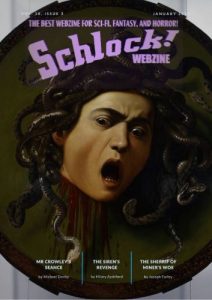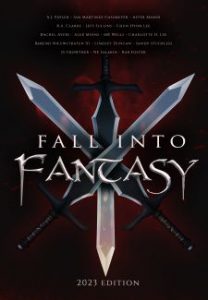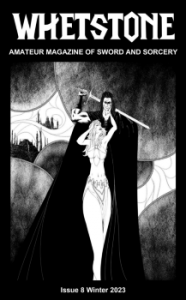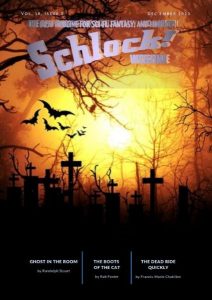
© The Horror Zine
If years were cars, then the one that’s just concluded, 2022, would definitely not be a sleek, shiny Aston Martin DB6 driven by Sean Connery in Goldfinger (1964). No, 2022 would more likely be an ugly, black-smoke-spewing, rolling-coal diesel pick-up truck driven by some Trump-loving, climate-change-denying, QAnon-believing, anti-vaxxer moron in Texas.
Thanks to wars, economic crises, environmental disasters and ongoing pestilence, I can’t imagine anyone claiming that 2022 was a vintage year. Well, maybe except for the Right Honourable Baroness Michelle Mone OBE, who at this moment is possibly raising a glass of bubbly and toasting the sight of Britain receding in the rear-view mirror of her luxury yacht, cruising at full speed towards some far-off, sun-kissed tax haven where she can enjoy the 29 million pounds that’s allegedly turned up in her and her children’s bank accounts. This windfall may have something to do with Michelle cannily using her position and influence to lobby the British government a while back, during the pandemic, and persuade them to hand over 200 million pounds of taxpayers’ money to the mysterious company PPE Medpro in return for it supplying the NHS with personal, protective equipment – equipment that, it transpired, “’did not comply with the specification in the contract’ and could not be used”.
Anyway, on a personal level, 2022 was a hectic one for me. It involved moving from Sri Lanka – not the result of the political and economic turmoil that erupted there earlier in the year, since I’d been planning to leave for some time before that – and coming to Singapore to start a new job. The stress of the move may have affected me in a few ways. For example, two things I normally love doing are reading books and watching films, yet in 2022 I’ve rarely had the concentration or been in the mood to do either. However, one area of my life that seems to have survived unscathed is my writing. I got a reasonable number of short stories published during the year, under the pseudonyms Jim Mountfield (used for my horror fiction) and Rab Foster (used for my fantasy fiction).
Here’s a round-up of those stories, who’s published them, and where you can find them.

© Schlock! Webzine
As Jim Mountfield:
- In March 2022, my story Never Tell Tales out of School, which drew on unhappy memories of playground bullying during the rough-and-tumble 1970s, and was inspired by the work of the masterly Liverpudlian horror writer Ramsey Campbell, was published in Volume 16, Issue 26 of Schlock! Webzine. The issue can currently be purchased as a paperback or Kindle edition here.
- Mermaid Fair – a story that involved both mermaids and, yes, a fair – was originally published in the now-defunct webzine Death Head Grin back in 2010. In March 2022, it was reprinted in the anthology Fearful Fun, from Thurston Howl Publications, which can be purchased here.
- March was also when I had the first of several stories published in 2022 in the magazine The Sirens Call. Liver, set on a farm and featuring a dysfunctional father-son relationship, plus much eating of red meat, appeared in Issue 57 of The Sirens Call, which can be downloaded here.
- And in July, it was the following issue of The Sirens Call that provided a home for my next story to appear in 2022. The magazine’s summer 2022 edition featured stories with a holiday theme. Thus, my story Selfless was about a holidaying couple in Thailand who come into possession of a strange smartphone that requires its owner to take lots of selfies. Endless selfies… The issue can be downloaded here.
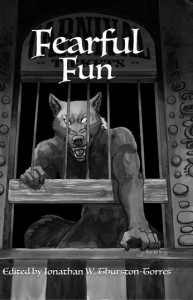
© Thurston Howl Publications
- My haunted-house story Coming Home originally appeared in the webzine The Horror Zine back in 2014. In September 2022, I was delighted when it was selected for the commemorative anthology The Best of the Horror Zine: The Middle Years, which showcased the webzine’s strongest stories published between 2013 and 2020. The collection can be purchased on Kindle or as a paperback here.
- In October, I made it into the pages of another anthology. Published by Cloaked Press LLC, Nightmare Fuel 2022: Objects of Horror featured stories where “what lurks in plain sight… is the true horror” and where the scares emanate from “such seemingly mundane items as an antique desk, a television, or a cute little stuffed elephant…” My story was about a set of haunted wind chimes and, unsurprisingly, was called The Chimes. Nightmare Fuel 2022: Objects of Horror can be obtained in Kindle or paperback versions here.
- October was also the month of Halloween, and I managed to get a story into Issue 59, the Halloween edition, of The Sirens Call. This was entitled Guising and took a nostalgic look at the custom of guising – the Scottish version of trick-or-treating – as kids practised it in the 1970s. Being a Jim Mountfield story, there was of course a gruesome ending. A copy of the Halloween edition can be downloaded here.
- Just before Christmas, my story Upstairs, inspired by the crumbling old French-Colonial-era apartment building that I lived in during my years in Tunisia, appeared in the December 2022 edition of ParABnormal Magazine, which can be purchased here.
- And at the end of the year, my story The Faire Chlaidh – which translates from Scottish Gaelic as ‘the graveyard watch’ and is about the old belief that one of the souls of the folk buried in a graveyard has to remain there and guard the place – appeared in Issue 60 of The Sirens Call. It can be obtained here.

© The Sirens Call
As Rab Foster:
- In January 2022, my fantasy story Crows of the Mynchmoor appeared in the ezine Swords and Sorcery Magazine. Not only about crows, but also about witches, sheep, scarecrows and, yes, turnips (beat that, George R.R. Martin), the story can now be read in the ezine’s archive section, here.
- And it was in Swords and Sorcery Magazine that my second Rab Foster story of the year appeared, in August. The Library of Vadargarn was about forbidden books, religious zealots and demons covered in bronze scales and, again, is available for reading in the ezine’s archives, here.
- Drayak Shathsprey, the hero of Crows of the Mynchmoor, made a second appearance in 2022. This was in the story The Tower and the Stars, published in the ezine Aphelion in October. The Tower and the Stars also featured another Rab Foster character, the witch Gudroon, who’d originally appeared in the anthology Swords & Sorceries: Tales of Heroic Fantasy, Volume 3, published in November 2021. The story is now available to read in Aphelion’s archive, here.
And that’s everything. A very Happy New Year to you all.
Let’s hope that – if years were cars – 2023 is more like that Aston Martin DB5 and less like a brazenly-polluting, smoke-belching pick-up truck that Andrew Tate would approve of. (Tate… Ha ha.) Oh, and let’s hope too that Michelle Mone’s luxury yacht hits an iceberg.

© Aphelion


